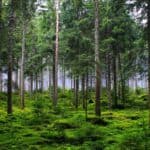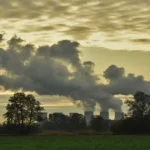Understanding the biome and ecosystem difference is essential for grasping how our natural world functions. Biomes are large areas defined by their climate, plants, and animals, like deserts and forests.
Ecosystems are smaller units within biomes, where living and non-living things interact.
Understanding the Key distinctions between biomes and ecosystems helps us appreciate the complexity of nature. It reveals how climate shapes large regions and how different species survive and thrive together in specific areas.
Knowing these differences can aid in conservation efforts and enhance our knowledge of environmental science. This awareness is crucial for protecting biodiversity and maintaining healthy ecosystems on our planet.
What is a Biome?
A biome is a large geographic area distinguished by its climate, soil, plants, and animals. It encompasses vast regions with similar environmental conditions.
Biomes are broader than ecosystems, which are smaller and more localized areas within biomes.
Characteristics of Biomes:
Climate: Biomes are primarily defined by their climate, which includes temperature and precipitation patterns. For example, deserts have hot days and cold nights with minimal rainfall, while rainforests are warm and receive heavy rain year-round.
These climate conditions influence the types of plants and animals that can live in each biome. The climate also affects the soil and water availability, which are crucial for supporting life in the biome.
Vegetation: Each biome has dominant plant types that are adapted to its specific climate. For instance, cacti thrive in deserts due to their ability to store water, while tall trees with broad leaves dominate rainforests, capturing sunlight in dense, humid environments.
These plants form the base of the food web, providing food and shelter for other organisms. The type of vegetation in a biome also influences the soil quality and the overall ecosystem health.
Fauna: The animal species found in a biome are adapted to its climate and vegetation. In the tundra, animals like caribou and arctic foxes have thick fur to withstand cold temperatures.
In contrast, tropical rainforests are home to a diverse array of species like jaguars, monkeys, and parrots, which have adapted to a warm, wet climate. Each animal plays a specific role in the ecosystem, contributing to nutrient cycling, energy flow, and ecological balance.
Soil: Soil types vary between biomes and support particular plant life. Desert soils are sandy and low in organic matter, while rainforest soils are nutrient-rich but can be quickly depleted by heavy rains.
The soil in a biome affects water retention, nutrient availability, and the types of vegetation that can grow. Healthy soil is essential for sustaining the plants and animals that make up the biome.
Geographical Location: Biomes are found in various parts of the world, each with unique environmental conditions. The location of a biome determines its climate, soil, and the types of plants and animals it supports.
For example, tundras are located in polar regions, while savannas are found in tropical and subtropical areas. Understanding the geographical location of biomes helps us appreciate the diversity of life on Earth and the complex interactions between organisms and their environment.
What is an Ecosystem?
An ecosystem is a community of living organisms interacting with their physical environment. This includes plants, animals, and microorganisms working together with non-living elements like soil, water, and air. Ecosystems can be as small as a pond or as large as a forest.
Characteristics of Ecosystems:
Biotic Components: Ecosystems are made up of biotic components, which include all living organisms. This means plants, animals, and microorganisms form the core of an ecosystem. Plants act as producers, creating food through photosynthesis.
Animals, both herbivores and carnivores, play their roles as consumers. Microorganisms like bacteria and fungi are decomposers, breaking down dead matter and returning nutrients to the soil.
Each biotic component has a specific role, contributing to the ecosystem’s overall health and balance.
Abiotic Components: In addition to living organisms, ecosystems include abiotic components. These are the non-living elements that influence the environment. Sunlight provides energy for photosynthesis, driving the food chain.
Water is essential for all life, influencing where organisms can live. Minerals and nutrients in the soil support plant growth, which in turn supports other life forms.
Other abiotic factors include temperature, air, and rocks. Together, these components create the physical environment in which biotic components interact.
Interactions and Energy Flow: The relationships between biotic and abiotic components are critical in an ecosystem. Interactions include predation, competition, and symbiosis. For example, predators hunt prey, maintaining population balance.
Plants and animals compete for resources like light and food. Symbiotic relationships, such as bees pollinating flowers, benefit both parties.
Energy flow is another key aspect, beginning with producers and moving up to consumers. Plants capture energy from the sun, herbivores eat the plants, and carnivores eat the herbivores.
Decomposers then break down dead organisms, returning nutrients to the soil, completing the cycle.
Nutrient Cycling: Nutrient cycling is a vital process in ecosystems. It involves the recycling of essential nutrients like carbon, nitrogen, and phosphorus. Decomposition is a major part of this process, where decomposers break down organic matter into simpler substances.
These nutrients are then absorbed by plants, starting the cycle anew. Photosynthesis also plays a role, as plants convert carbon dioxide into oxygen.
This continuous recycling ensures that nutrients are available for all living organisms, maintaining ecosystem productivity and health.
Also Read: A Guide to the Different Forest Types Found in India
Key Distinctions Between Biome and Ecosystem
Understanding the key distinctions between biomes and ecosystems is crucial for grasping ecological concepts. A biome is a larger geographic area with a specific climate and species.
It spans extensive regions, like deserts or rainforests, defined by their consistent weather patterns and dominant plant life.
In contrast, an ecosystem is a smaller area within a biome where organisms interact with their environment. For instance, a pond in a forest or a coral reef in the ocean is considered an ecosystem.
These ecosystems exist within the larger framework of biomes, contributing to the broader ecological patterns.
When examining components and structure, a biome is primarily defined by abiotic factors. These include climate, soil, and the predominant vegetation that thrives in these conditions. Biomes are categorized based on these non-living elements and the large-scale environmental features.
On the other hand, an ecosystem includes both biotic and abiotic components. This means ecosystems consider living organisms like plants, animals, and microorganisms, along with non-living factors such as water, sunlight, and minerals.
The interaction between these components is what defines an ecosystem.
Ecosystems fit within biomes, providing a more detailed look at the living conditions within these vast regions. For example, the Amazon Rainforest is a biome characterized by high rainfall and dense forests.
Within this biome, there are countless ecosystems, such as rivers, wetlands, and forest floors, each with distinct interactions among species. Similarly, the Sahara Desert, a biome known for its arid conditions, contains ecosystems like oases and sand dunes, where specific organisms adapt to the harsh environment.
These examples illustrate how ecosystems operate within the broader context of biomes, highlighting the intricate relationships and diversity of life on Earth.
Importance of Biomes and Ecosystems
Biomes and ecosystems play vital roles:
Role in the Environment
Biomes and ecosystems play a vital role in maintaining environmental stability. Biomes regulate global climate patterns by influencing temperature and precipitation.
For example, rainforests help produce oxygen and absorb carbon dioxide, mitigating climate change. Ecosystems, on a smaller scale, provide essential services like nutrient cycling, water purification, and soil formation.
Wetlands, for instance, filter pollutants from water, making it cleaner for other uses. These natural processes are crucial for sustaining life on Earth.
Contribution to Biodiversity
Biomes and ecosystems are fundamental for preserving biodiversity. Each biome supports unique species adapted to its specific climate and conditions.
For example, the Arctic tundra is home to polar bears and arctic foxes, while tropical rainforests house a vast array of plant and animal species. Ecosystems within these biomes offer diverse habitats, ensuring survival and reproduction.
Coral reefs, despite covering a small area, harbour a significant portion of marine life. Protecting these areas is essential for maintaining the planet’s biological richness.
Impact on Human Life and the Planet
The health of biomes and ecosystems directly affects human life and the planet. They provide resources like food, water, and medicine. Forests supply timber and support livelihoods, while oceans offer fish and other seafood.
Ecosystems also help mitigate natural disasters; mangroves, for example, protect coastlines from storm surges. Additionally, healthy biomes and ecosystems contribute to recreational and cultural values.
Conserving these natural areas is crucial for sustaining human well-being and ensuring a balanced and healthy planet for future generations.
Conclusion
Understanding the biome and ecosystem difference is essential for appreciating how nature is structured. Biomes are large areas defined by climate and dominant vegetation, while ecosystems are smaller communities within biomes where living and non-living components interact.
This knowledge helps us see the big picture and the finer details of our environment.
“Understanding the Key Distinctions” between biomes and ecosystems can enhance our efforts to conserve biodiversity. Recognizing how these systems function and support life is crucial for sustainable living. Protecting biomes and ecosystems ensures the health of our planet.
For those interested in learning more, consider reading about specific biomes and ecosystems. Delving deeper into their roles and interactions can offer valuable insights into ecological balance and conservation.






